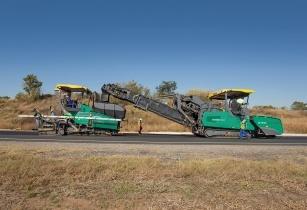Proof comes from the University of Twente, Netherlands, which monitored the project from a scientific perspective – and their equipment included RoadScan, the innovative temperature measurement system from VÖGELE
A job site in South Africa has demonstrated that the VÖGELE MT 3000-2 Offset PowerFeeder improves pavement quality. Organising paving work so that it can proceed without interruption in order to enhance quality is one of the key reasons for using material feeders.
An advanced VÖGELE MT 3000-2 Offset PowerFeeder with a VÖGELE SUPER 1800-2 paver was used for the rehabilitation of a 4km-long stretch of the N14 national route near Johannesburg by the South African construction company Power Construction (Pty) Ltd.
On the job site, scientists from the University of Twente investigated whether the innovative VÖGELE material feeder improved the quality of the paved binder and surface courses. One of the crucial factors was the temperature of the asphalt immediately after paving. The temperature was measured using two mutually independent systems, one of which was RoadScan, the non-contacting temperature measurement system from VÖGELE. To provide a comparison, some sections were also completed without using a material feeder.
The MT 3000-2 Offset PowerFeeder features an intelligent material transport and storage concept with a total capacity of 43t. Lorries carrying 25t of mix can be unloaded within 60 seconds. That enabled paving on the job site located on the outskirts of Johannesburg to proceed without interruptions. This is of central importance to pavement quality because interruptions cause a wide range of problems, the main one being the cooling of the mix and the associated reduction in compatibility, not to mention the loss of time involved. Undesired side effects such as these occurred on sections where the paving work was carried out without a material feeder for the purposes of comparison.
One of the main advantages of the VÖGELE PowerFeeder over conventional paving is its integrated heating system. The powerful infrared heating with non-contacting panels over the conveyor is a solution offered only by VÖGELE. It actively counteracts the temperature drop that arises in the transport chain between the mix leaving the mixing plant and being compacted, vastly improving pavement quality. This, too, is demonstrated by the university study: it found that the VÖGELE material feeder constantly guaranteed a homogeneous heat distribution in the freshly laid asphalt pavement. In the N14 project, the asphalt temperature never fell below 120°C immediately after paving, which left a large window of time for final compaction by HAMM rollers.
It is a key advantage in the field: the PowerFeeder reaches the high temperatures right at the start of paving – and requires no heating phase. This goes to show that VÖGELE‘s engineers were perfectly in tune with requirements and developed the PowerFeeder to meet the specific challenges of tough, day-to-day job-site operations.




